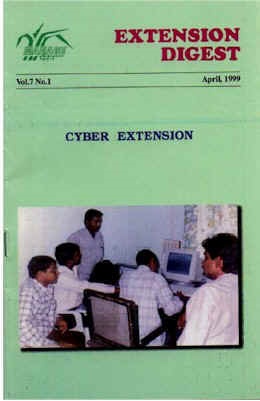



Extension Digest - 1999

April 1999, Theme: Cyber extension, Vol.7 No.1
Abstract
Access to information and improved communication is a crucial requirement for sustainable agricultural development. Modern communication technologies when applied to conditions in rural areas can help improve communication, increase participation, disseminate information and share knowledge and skills. It is being said that "Cyber Extension" would be the major form of technology dissemination in the near future.
However it is observed that the rural population still have difficulty in accessing crucial information in order to make timely decisions. It is essential that information availability is demand driven rather than supply driven. The challenge is not only to improve the accessibility of communication technology to the rural population but also to improve its relevance to local development.
Considering the critical need for access to timely information and improved communication, this issue focuses on attempts made in different countries to transfer information to the rural population and success stories of such attempts. Bridging the '"last mile" between the haves and have nots will ensure that remote rural communities are better informed. Full Text

Jan 1999, Theme: Trends in Agricultural extension, Vol.6 No.4
Abstract
There is increasing acceptance that agricultural research and extension need to be more responsive to the needs and constraints of the farming community. The need for empowering farmers, decentralizing government services, involving the private sector and linking rural people to research, extension and to each other through information technology for facilitating access to crucial information is also recognized.
This issue of the Extension Digest, focuses on trends, challenges to extension, need for partnerships among government, non-governmental sector, farmers and other development agencies, approaches to extension and models.
Selected abstracts on challenges, services and approaches are also appended. Full Text

July 1999, Theme: Watershed Management, Vol.7 No.2
Abstract
There is an increase in concern about watershed problems and interest in methods of meeting them, around the world.Concern over repeated floods, excessive siltation, accelerated erosion with loss of soil and productive capacity have resulted in an interest in measure to correct these situations and prevent their occurence.
Watershed managemnt, is a holistic approach which aims at optimising the use of land, water and vegetation to alleviate drought, moderate floods, prevent soil erosion, improve water availability and increase fuel, fodder agricultural production on a sustained basis.
There is an urgent need to improve Watershed management and to educate the general public on watershed problems and actions needed to meet these problems.This issue of Extension Digest focuses on the Common Approach for Watershed Mangement, importance of indigenous technical knowledge, information technology applications in Watershed management and documents successes across the country. Full Text






